WP1 - LHC consolidation, upgrades and R&D for future hadron machines
WP1 - LHC consolidation, upgrades and R&D for future hadron machines
WP1 covers the LHC exploitation and upgrades in particular linking to the planned Japanese contributions to these projects, as well as R&D for future hadron machine at higher intensity or energy. LHC will run near its full energy from 2015 and Japanese researchers participate in operation, analysis and upgrade projects for both accelerator and detectors. R&D on high field magnets and wideband magnetic alloy RF systems carried out in Japan is a key ingredient for upgrading the LHC itself as well as its injectors - through the LHC Injectors Upgrade project - and for reaching the performance goals of the High Luminosity LHC (HL- LHC) project. This is also relevant for the J-PARC upgrades and, at a later stage, for a potential very large collider as studied in the Future Circular Collider (FCC) programme. The main objective for this work-package is integration of the European and Japanese efforts (involving also other regions) on the LHC High Luminosity upgrade into a construction project for the upgrade hardware.
WP1 Tasks
Task 1.1: LHC operation and analysis (CERN, KEK & UoT): Integrate Japanese efforts in operation of LHC machines and detectors at full energy; expected to provide important guidance for future accelerator developments in Europe and Japan.
Task 1.2: The HL-LHC project (CERN & KEK): Engineering design and validation of two short prototype separation superconducting dipoles (D1) followed by construction preparation, construction and test of the 4 final (plus two spare) D1 dipoles for the upgraded LHC insertion regions. Studies for the crab cavities (CC) for the LHC luminosity upgrade, benefitting from operational experience of CC at KEK.
Task 1.3: High field magnet R&D and preparation of future hadron injectors and colliders (CERN & KEK): R&D on the viability of HTS magnets of accelerator/collider quality. Enhance the exchange of staff between CERN and KEK in the context of the LIU project and the J- PARC intensity upgrade studies. Technologies of special interest are Wideband Cavities using Magnetic Alloy, Solid State Amplifiers and Low Level RF.
Organisation
CERN, KEK and the University of Tokyo participate in WP1. The work package leader is Lucio Rossi (CERN).
